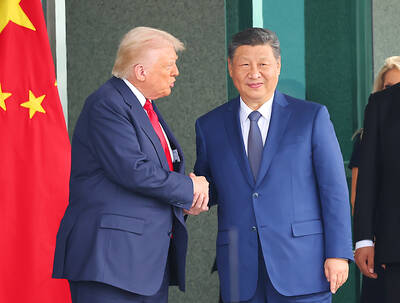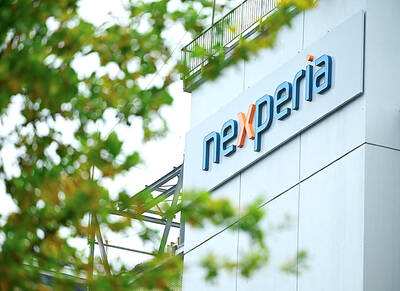Chlitina Holding Ltd (麗豐), a China-based beauty product manufacturer, on Thursday said that it would focus on royalty income from its direct-sales subsidiary, as well as the development of e-commerce this year.
While the company has continued to consolidate its brick-and-mortar channels and gradually implemented a store management system to enhance its franchise management, it also wants to pay equal attention to its wholly owned direct-sales unit, Kelti China (克緹中國), and its newly installed Beauty Health Happiness (新美力) e-commerce platform.
The company’s pledges come as it reported stronger-than-expected profit for last year, with net profit rising from NT$755.84 million in 2014 to NT$1.17 billion last year (US$23.07 million to US$35.71 million). Earnings per share were NT$14.68 last year, compared with NT$9.51 a year earlier.
“We saw our growth last year mainly derived from China operations,” the company told investors at a earnings conference organized by the Taiwan Stock Exchange in Taipei on Thursday.
Chlitina began its business in Taiwan in 1989 and tapped into the Chinese market in 1997. It now has more than 200 in Taiwan and more than 3,400 stores in China.
Apart from contributions from its brick-and-mortar distribution channels, Chlitina also counted on Kelti China and e-commerce business to drive its revenue to grow 43.07 percent year-on-year to NT$4.39 billion last year.
Chlitina obtains royalty income from Kelti China by authorizing relevant trademark rights for 3DR and Peekaboo beauty-care brands. The company said it receives 6 percent of Kelti China’s sales in royalty fees if its subsidiary’s monthly revenue derived from authorized cosmetics and skincare products exceeds 10 million yuan (US$1.5 million).
As Kelti China’s revenue jumped by 525 percent annually to 4 billion yuan last year, the Chinese subsidiary has become the 10th largest direct-sales distributor in China and an emerging revenue contributor to its parent company.
The company in July last year launched the Beauty Health Happiness platform and introduced online-to-offline service to help integrate its virtual channels with brick-and-mortar stores.
Chlitina said this year it plans to make inroads into other platforms, roll out apps and construct an online shopping mall in a bid to enhance consumer experience with a wider product range.
“The contribution of e-commerce sales is still low, but we see great potential going forward,” Yuanta Securities Investment Consulting Co (元大投顧) said in a note on March 9.
China’s economic growth slowed to 6.9 percent last year, the country’s slowest expansion in a quarter of a century, but the country’s growing income per capita and an expanding middle-class are expected to continue benefiting the cosmetics and personal care industry, Capital Securities Corp (群益證券) said in a note on March 15.
Against this backdrop, Chlitina is forecast to see revenue increase 12.5 percent to NT$4.94 billion this year, with earnings per share predicted to reach NT$18.32, Capital Securities said.
Yuanta predicted Chlitina’s sales would grow 17 percent to NT$5.15 billion this year, but lowered its earnings forecast to NT$17.15 citing the firm’s higher operating expense driven by increased marketing activities and the costs of constructing a new management system.
Chlitina has proposed to distribute a cash dividend of NT$10 to shareholders this year, which represents a payout ratio of 68.1 percent.
The planned dividend payout also translates into a dividend yield of 3.78 percent based on the firm’s share price of NT$264.5 at the close of Taipei trading on Friday.
Additional reporting by Kevin Chen

RUN IT BACK: A succesful first project working with hyperscalers to design chips encouraged MediaTek to start a second project, aiming to hit stride in 2028 MediaTek Inc (聯發科), the world’s biggest smartphone chip supplier, yesterday said it is engaging a second hyperscaler to help design artificial intelligence (AI) accelerators used in data centers following a similar project expected to generate revenue streams soon. The first AI accelerator project is to bring in US$1 billion revenue next year and several billion US dollars more in 2027, MediaTek chief executive officer Rick Tsai (蔡力行) told a virtual investor conference yesterday. The second AI accelerator project is expected to contribute to revenue beginning in 2028, Tsai said. MediaTek yesterday raised its revenue forecast for the global AI accelerator used

TEMPORARY TRUCE: China has made concessions to ease rare earth trade controls, among others, while Washington holds fire on a 100% tariff on all Chinese goods China is effectively suspending implementation of additional export controls on rare earth metals and terminating investigations targeting US companies in the semiconductor supply chain, the White House announced. The White House on Saturday issued a fact sheet outlining some details of the trade pact agreed to earlier in the week by US President Donald Trump and Chinese President Xi Jinping (習近平) that aimed to ease tensions between the world’s two largest economies. Under the deal, China is to issue general licenses valid for exports of rare earths, gallium, germanium, antimony and graphite “for the benefit of US end users and their suppliers

Dutch chipmaker Nexperia BV’s China unit yesterday said that it had established sufficient inventories of finished goods and works-in-progress, and that its supply chain remained secure and stable after its parent halted wafer supplies. The Dutch company suspended supplies of wafers to its Chinese assembly plant a week ago, calling it “a direct consequence of the local management’s recent failure to comply with the agreed contractual payment terms,” Reuters reported on Friday last week. Its China unit called Nexperia’s suspension “unilateral” and “extremely irresponsible,” adding that the Dutch parent’s claim about contractual payment was “misleading and highly deceptive,” according to a statement

The Chinese government has issued guidance requiring new data center projects that have received any state funds to only use domestically made artificial intelligence (AI) chips, two sources familiar with the matter told Reuters. In recent weeks, Chinese regulatory authorities have ordered such data centers that are less than 30 percent complete to remove all installed foreign chips, or cancel plans to purchase them, while projects in a more advanced stage would be decided on a case-by-case basis, the sources said. The move could represent one of China’s most aggressive steps yet to eliminate foreign technology from its critical infrastructure amid a